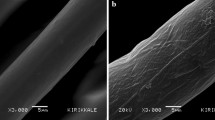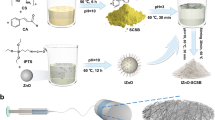Abstract
In this work, a kind of amine-type PET fibers was synthesized by reacting hexamethylenediamine (HMDA) with methacrylic acid-g-poly(ethylene terephthalate) (PET-g-MAA) fibers for the adsorption of silk sericin-capped silver nanoparticles (S-AgNPs) to produce antimicrobial fibers. Firstly, PET fibers were grafted MAA by using free radical polymerization technique and HMDA was covalently connected to the grafted PET fibers. Then, for S-AgNPs synthesis, 10 mL of AgNO3 solution (1 mM, 5 mM and 10 mM) was mixed with 10 mL of 1% sericin solution at pH 11. The obtained solution was stirred at room temperature for 24 h. The color change from transparent to yellow–brown indicated the formation of S-AgNPs. AgNPs formation was also determined by measuring the absorbance spectra of S-AgNPs between 300 and 600 nm using UV–Vis spectrophotometer. To determine the antimicrobial properties of S-AgNPs, agar-well diffusion tests were performed. 5 mM and 10 mM S-AgNPs groups showed antimicrobial activity on Escherichia coli and Staphylococcus aureus. After characterization of the synthesized S-AgNPs with UV–Vis spectrophotometer, Zetasizer, FTIR and TEM, the modified PET fibers were coated with S-AgNPs (5 mM and 10 mM). The S-AgNPs coated PET fibers were characterized by FTIR, SEM and X-ray fluorescence spectroscopy. The antimicrobial activities of the obtained PET fibers were investigated on S. aureus and E. coli bacteria by using disk diffusion test. It was found that the S-AgNPs coated modified PET fibers exhibited antimicrobial activities toward both gram-positive and gram-negative bacteria. The resulting polymeric PET fibers containing nano-silver can be used as an antimicrobial surface for many applications such as wound dressing.










Similar content being viewed by others
References
Kumar V, Jolivalt C, Pulpytel J, Jafari R, Arefi-Khonsari FA (2012) Development of silver nanoparticle loaded antibacterial polymer mesh using plasma polymerization process. J Biomed Mater Res A 101:1121–1132. https://doi.org/10.1002/jbm.a.34419
Bisson I, Kosinski M, Ruault S, Gupta B, Hilborn J, Wurm F (2002) Acrylic acid grafting and collagen immobilization on poly(ethylene terephthalate) surfaces for adherence and growth of human bladder smooth muscle cells. Biomaterials 23:3149–3158. https://doi.org/10.1016/S0142-9612(02)00061-3
Gupta B, Mishra S, Saxena S (2008) Preparation of thermosensitive membranes by radiation grafting of acrylic acid/N-isopropyl acrylamide binary mixture on PET fabric. Radiat Phys Chem 77:553–560. https://doi.org/10.1016/j.radphyschem.2007.09.001
Jeon DH, Lee KH, Park HJ (2004) The effects of irradiation on physicochemical characteristics of PET packaging film. Radiat Phys Chem 71:1059–1064. https://doi.org/10.1016/j.radphyschem.2003.10.009
Ping X, Wang M, Ge X (2011) Surface modification of poly(ethylene terephthalate) (PET) film by gamma-ray induced grafting of poly(acrylic acid) and its application in antibacterial hybrid film. Radiat Phys Chem 80:567–572. https://doi.org/10.1016/j.radphyschem.2010.12.011
Fragal VH, Cellet TSP, Pereira GM, Fragal EH, Costa MA, Nakamura CV, Asefa T, Rubira AF, Silva R (2016) Covalently-layers of PVA and PAA and in situ formed Ag nanoparticles as versatile antimicrobial surfaces. Int J Biol Macromol 91:329–337. https://doi.org/10.1016/j.ijbiomac.2016.05.056
Deng X, Nikiforov A, Vujosevic D, Vuksanovic V, Mugoša B, Cvelbar U, Geyter ND, Morent R, Leys C (2015) Antibacterial activity of nano-silver non-woven fabric prepared by atmospheric pressure plasma deposition. Mater Lett 149:95–99. https://doi.org/10.1016/j.matlet.2015.02.112
Pour SN, Ghugare SV, Wiens R, Gough K, Liu S (2015) Controlled in situ formation of polyacrylamide hydrogel on PET surface via SI-ARGET-ATRP for wound dressings. Appl Surf Sci 349:695–704. https://doi.org/10.1016/j.apsusc.2015.04.181
Shu YT, Kao KT, Weng CS (2017) In vitro antibacterial and cytotoxic activities of plasma-modified polyethylene terephthalate nonwoven dressing with aqueous extract of Rhizome Atractylodes macrocephala. Mater Sci Eng, C 77:606–612. https://doi.org/10.1016/j.msec.2017.03.291
Pillai ZS, Kamat PV (2004) What factors control the size and shape of silver nanoparticles in the citrate ion reduction method. J Phys Chem B 108:945–951. https://doi.org/10.1021/jp037018r
Soroushian B, Lampre I, Belloni J, Mostafavi M (2005) Radiolysis of silver ion solutions in ethylene glycol: solvated electron and radical scavenging yields. Radiat Phys Chem 72:111–118. https://doi.org/10.1016/j.radphyschem.2004.02.009
Zhu JJ, Liao XH, Zhao XN, Hen HY (2001) Preparation of silver nanorods by electrochemical methods. Mater Lett 49:91–95. https://doi.org/10.1016/S0167-577X(00)00349-9
Thomas R, Viswan A, Mathew J, Radhakrishnan EK (2012) Evaluation of antibacterial activity of silver nanoparticles synthesized by a novel strain of marine Pseudomonas sp. Nano Biomed Eng 4:139–143. https://doi.org/10.5101/nbe.v4i3.p139-143
Aramwit P, Bang N, Ratanavaraporn J, Ekgasit S (2014) Green synthesis of silk sericin-capped silver nanoparticles and their potent anti-bacterial activity. Nanoscale Res Lett 9:79–86. https://doi.org/10.1186/1556-276X-9-79
Senthamilselvi S, Kumar P, Prabha AL, Govindaraju M (2013) Green simplistic biosynthesis of anti-bacterial silver nanoparticles using Annona squamosa leaf extract. Nano Biomed Eng 5:102–106. https://doi.org/10.5101/nbe.v5i2.p102-106
Logeswari P, Silambarasan S, Abraham J (2015) Synthesis of silver nanoparticles using plants extract and analysis of their antimicrobial property. J Saudi Chem Soc 19:311–317. https://doi.org/10.1016/j.jscs.2012.04.007
Coşkunçay S (2017) Biosynthesis of silver nanoparticles using horse chestnut (Aesculus hippocastanum) leaf extract, determination of biologic activities and drug release properties. Dissertation, Erciyes University
Oluwafemi OS, Vuyelwa N, Scriba M, Songca SP (2013) Green controlled synthesis of monodispersed, stable and smaller sized starch-capped silver nanoparticles. Mater Lett 106:332–336. https://doi.org/10.1016/j.matlet.2013.05.001
AL-Thabaiti NS, Malik MA, Khan Z (2017) Protein interactions with silver nanoparticles: green synthesis, and biophysical approach. Int J Biol Macromol 95:421–428. https://doi.org/10.1016/j.ijbiomac.2016.11.046
Aramwit P, Siritientong T, Srichana T (2012) Potential applications of silk sericin, a natural protein from textile industry by-products. Waste Manag Res 30:212–224. https://doi.org/10.1177/0734242X11404733
Wu JH, Wang Z, Xu SY (2007) Preparation and characterization of sericin powder extracted from silk industry waste water. Food Chem 103:1255–1262. https://doi.org/10.1016/j.foodchem.2006.10.042
Aramwit P, Damrongsakkul S, Kanokpanont S, Srichana T (2010) Properties and antityrosinase activity of sericin from various extraction methods. Biotechnol Appl Biochem 55:91–98. https://doi.org/10.1042/BA20090186
Siritientong T, Angspatt A, Ratanavaraporn J, Aramwit PN (2014) Clinical potential of a silk sericin-releasing bioactive wound dressing for the treatment of split-thickness skin graft donor sites. Pharm Res 31:104–116. https://doi.org/10.1007/s11095-013-1136-y
Anjum S, Gupta A, Sharma D, Kumari S, Sahariah P, Bora J, Bhan S, Gupta B (2017) Antimicrobial nature and healing behavior of plasma functionalized polyester sutures. J Bioact Compat Polym 32(3):263–279. https://doi.org/10.1177/0883911516668665
Wang Y, Zhao J, Sha L, Zhu Y, Li X (2018) Design of broad-spectrum antimicrobial polyethylene terephthalate fabrics by coating composited natural brucites. J Mater Sci 53:1610–1622. https://doi.org/10.1007/s10853-017-1648-7
Yuel X, Lin H, Yan T, Zhang D, Lin H, Chen Y (2014) Synthesis of silver nanoparticles with sericin and functional finishing to cotton fabrics. Fiber Polym 15:716–722. https://doi.org/10.1007/s12221-014-0716-8
Arslan M (2011) Immobilization horseradish peroxidase on amine functionalized glycidyl methacrylate-g-poly(ethylene terephthalate) fibers for use in azo dye decolorization. Polym Bull 66:865–879. https://doi.org/10.1007/s00289-010-0316-8
Arslan M, Günay K (2018) Synthesis of amine-functionalized methacrylic acid-g-poly(ethylene terephthalate) fiber and its Congo red removal ability. Polym Bull 75:1701–1713. https://doi.org/10.1007/s00289-017-2121-0
Mittal H, Ray SS (2016) A study on the adsorption of methylene blue onto gum ghatti/TiO2 nanoparticles-based hydrogel nanocomposite. Int J Biol Macromol 88:66–80. https://doi.org/10.1016/j.ijbiomac.2016.03.032
Ning CC, Logsetty S, Ghughare S, Liu S (2014) Effect of hydrogel grafting, water and surfactant wetting on the adherence of PET wound dressings. Burns 40:1164–1171. https://doi.org/10.1016/j.burns.2013.12.024
Du Y, Du Z, Zou W, Li H, Mi J, Zhang C (2013) Carbon dioxide adsorbent based on rich amines loaded nano-silica. J Colloid Interface Sci 409:123–128. https://doi.org/10.1016/j.jcis.2013.07.071
Gao F, Gu H, Wang H, Wang X, Xiang B, Guo Z (2015) Magnetic amine-functionalized polyacrylic acid-nanomagnetite for hexavalent chromium removal from polluted water. RSC Adv 5:60208–60219. https://doi.org/10.1039/c5ra09761d
Šileikaitė A, Prosyčeva I, Puıšo J, Juraitis A, Guobıenė A (2006) Analysis of silver nanoparticles produced by chemical reduction of silver salt solution. Mater Sci 12:287–291
National Committee for Laboratory Standards (2003) Performance standards for antimicrobial disk susceptibility tests. Approved standard M2-A8. NCCLS, Wayne
Knill CJ, Kennedy JF (2003) Degradation of cellulose under alkaline conditions. Carbohydr Polym 51:281–300. https://doi.org/10.1016/S0144-8617(02)00183-2
Tongsakul D, Wongravee K, Thammacharoen C, Ekgasit S (2012) Enhancement of the reduction efficiency of soluble starch for platinum nanoparticles synthesis. Carbohydr Res 357:90–97. https://doi.org/10.1016/j.carres.2012.04.012
Vigneshwaran N, Nachane RP, Balasubramanya RH, Varadarajan PV (2006) A novel one-pot ‘green’ synthesis of stable silver nanoparticles using soluble starch. Carbohydr Res 341:2012–2018. https://doi.org/10.1016/j.carres.2006.04.042
Shin Y, Bae IT, Exarhos GJ (2009) Green approach for self-assembly of platinum nanoparticles into nanowires in aqueous glucose solutions. Colloids Surf A Physicochem Eng Asp 348:191–195. https://doi.org/10.1016/j.colsurfa.2009.07.013
Aktürk Ö, Gün Gök Z, Erdemli Ö, Daş TM (2018) Synthesis and characterization of sericin-capped gold nanoparticles. J Fac Eng Archit Gaz 33(2):675–684. https://doi.org/10.17341/gazimmfd.416377
Socrates G (2000) Infrared and Raman characteristic group frequencies: table and chart. Wiley, Chichester
Wang W, Chenga W, Tiana M, Zoua H, Li L, Zhanga L (2012) Preparation of PET/Ag hybrid fibers via a biomimetic surface functionalization method. Electrochim Acta 79:37–45. https://doi.org/10.1016/j.electacta.2012.06.063
Abdolahifard M, HajirBahrami S, Malek RMA (2011) Surface modification of PET fabric by graft copolymerization with acrylic acid and its antibacterial properties. ISRN Org Chem 2011:1–8. https://doi.org/10.5402/2011/265415
Liu C, Bai R, Quan San L (2008) Selective removal of copper and lead ions by diethylenetriamine-functionalized adsorbent: behaviors and mechanisms. Water Res 42(6–7):1511–1522. https://doi.org/10.1016/j.watres.2007.10.031
Hu XP, Li WY, Wang YZ (2004) Synthesis and characterization of a novel nitrogen-containing flame retardant. J Appl Polym Sci 94(4):1556–1561. https://doi.org/10.1002/app.20792
Acknowledgements
The work was supported by The Scientific and Technological Research Council of Turkey (TUBITAK) under the project number 218S449. The authors are grateful to TUBITAK for their support.
Author information
Authors and Affiliations
Corresponding author
Additional information
Publisher's Note
Springer Nature remains neutral with regard to jurisdictional claims in published maps and institutional affiliations.
Rights and permissions
About this article
Cite this article
Gün Gök, Z., Günay, K., Arslan, M. et al. Coating of modified poly(ethylene terephthalate) fibers with sericin-capped silver nanoparticles for antimicrobial application. Polym. Bull. 77, 1649–1665 (2020). https://doi.org/10.1007/s00289-019-02820-0
Received:
Revised:
Accepted:
Published:
Issue Date:
DOI: https://doi.org/10.1007/s00289-019-02820-0




